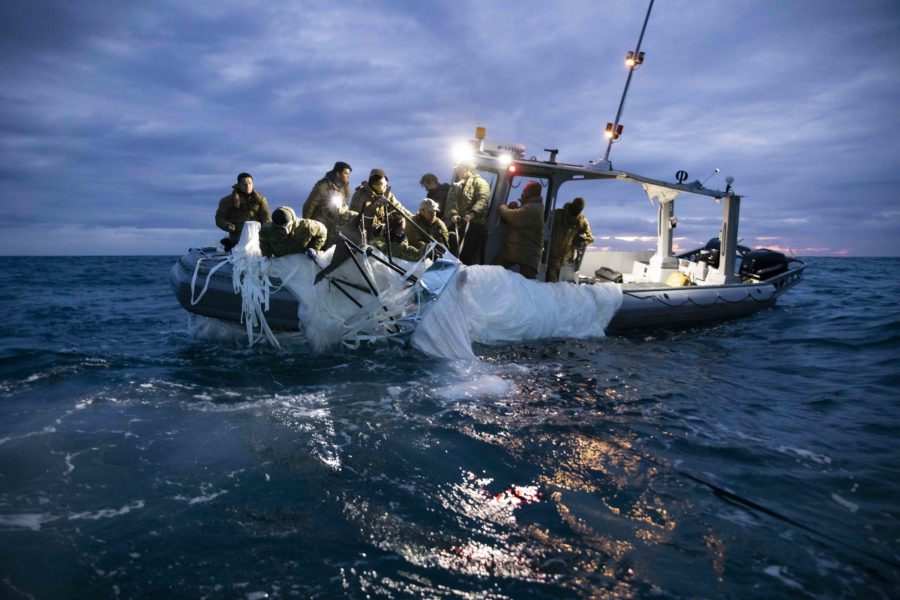The following commentary is written by Brian J. Morra, a former Air Force Intelligence officer and retired senior aerospace executive. His most recent article for Air & Space Forces Magazine was “The Near Nuclear War of 1983.” His novel about the 1983 incident, titled The Able Archers, was released in March 2022.
The appearance of a Chinese surveillance balloon over North America in recent days should cause Americans to ponder just how safe they are from aerial attack. Can we defend our airspace from modern drones (unmanned air vehicles), hypersonic missiles, ballistic missiles, and—yes—from airships? Congress should hold hearings promptly to determine the answer.
The war in Ukraine has highlighted the lethal impact of air and missile attacks on civilian lives and economic infrastructure. New graphic images of the destruction wrought by Russia’s air campaign against Ukraine appear daily. Ukraine’s economy is now operating at Depression-era levels. Is the United States any better protected?
The fact is that the United States has not deployed a robust air defense system to secure its territory since the Cold War. Does the American public realize this? Does Congress? We’ve seen in Ukraine that the absence of an integrated national air defense leads to vast death and destruction.
On Feb. 6, Air Force Gen. Glen D. VanHerck, the commander of North American Aerospace Defense Command (NORAD), told reporters that his command had not been aware of previous balloon incursions by the People’s Republic of China (PRC). He asserted that “we did not detect those threats and that’s a domain awareness gap that we have to figure out, but I don’t want to get into any further detail.” Uniquely, NORAD is a binational U.S.-Canada organization that detects air threats to both countries under a unified command structure.
The same day that Gen. VanHerck met with the press, the Chinese government confirmed reports that a Chinese balloon had floated over Latin America and the Caribbean. “These balloons are all part of a PRC fleet of balloons developed to conduct surveillance operations, which have also violated the sovereignty of other countries.” Brig. Gen. Patrick S. Ryder, the Pentagon press secretary, told reporters.
Apparently, the intelligence community has reassessed indications of four balloon incursions dating back to the Trump administration and determined that they also were perpetrated by the PRC.
According to the White House, the balloon that traversed the United States was first detected on Jan. 28 when it entered Alaskan airspace near the Aleutian Islands. By the end of the day on Jan. 30, it exited American airspace and flew over Canada. The PRC’s balloon re-entered American airspace over Idaho on the Jan. 31. Gen. Mark Milley, chairman of the Joint Chiefs of Staff, briefed President Biden about the presence of the balloon on Jan. 31. The president requested military options to deal with the intruder.
Congress should ask the following questions. Why was the president not briefed until Jan. 31 when the balloon entered American airspace on Jan. 28? What is the protocol for informing the White House about an airspace intruder? How clearly do the White House and the Congress understand the respective roles and missions of NORAD and the Missile Defense Agency regarding air and missile threats? Is there a seamless and timely command structure for assessing and dealing with air and missile threats to the United States?
The answers are important because the United States and Canada already face several daunting threats. The most alarming potential threat is a nuclear-armed ballistic missile launched by North Korea. And one must assume that Kim Jong Un has paid careful attention to the Chinese balloon incursion. In past years, Kim has threatened the use of an electromagnetic pulse device to cripple North America. A high-altitude airship might be an ideal delivery platform for such a devastating attack.
For its part, China is in the midst of a massive nuclear arms buildup, shedding its long-stated nuclear policy of “sufficiency” and aiming for nuclear superiority over both Russia and the United States. This week, U.S. Strategic Command issued an unclassified statement stating that China now has more land-based ballistic missile launchers than the U.S. China is advancing its nuclear modernization program faster than most observers thought possible. Both Russia and China have robust hypersonic missile programs, which are designed to defeat our ballistic missile defenses in Alaska and Europe. Iran threatens to deploy a nuclear weapon soon, and it has the means to develop delivery systems for such a weapon.
Congress ought to hold hearings and ask the appropriate defense and intelligence community officials to explain their plans to protect America. If roles and missions are unclear, then get them clarified. If resources are insufficient, which they surely are when our Air Force has the oldest fleet of planes in its history, then Congress should lead the way in determining where money can be reallocated to national air and missile defense without increasing the defense budget. There are plenty of legacy platforms and failed programs the armed services want to divest, where money could be harvested and re-purposed to improve the nation’s air and missile defenses.
Congress has opposed most of the services’ requests to sunset aging platforms and end non-performing programs because members don’t want to take the political heat for job losses in their districts. For the same reason, Congress opposes a new base realignment and closure commission. Closing bases the armed services no longer need would free up billions of dollars that could be applied to improving our national defenses.
The Chinese balloon episode ought to be a wake-up call to the White House and the Congress and not be wished away as the next crisis comes to dominate the headlines. Hold hearings now and take appropriate action based on what is learned. There is no time to waste.


